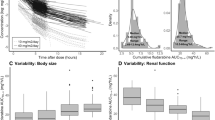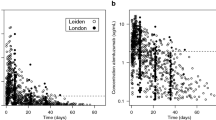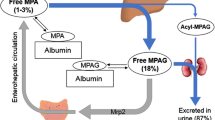Abstract
Fludarabine is used as a common component of conditioning regimens for haematopoietic stem cell transplantation (HSCT). However, knowledge regarding the pharmacokinetic characteristics of once-daily fludarabine dosing in children is limited. This study investigated the pharmacokinetics of fludarabine and evaluated its associations with clinical outcomes in paediatric patients. A total of 802 blood samples obtained from 43 paediatric patients who underwent HSCT were included in a population pharmacokinetic analysis using non-linear mixed-effects modelling. The relationships between systemic 9-β-d-arabinofuranosyl-2-fluoroadenine (F-ara-A) exposure derived from the model and the clinical outcome variables were explored. A two-compartment model with proportional residual error adequately described the pharmacokinetics of F-ara-A. The body surface area and glomerular filtration rate were significant covariates for the clearance of F-ara-A. After the first dose of fludarabine at 40 mg/m2, the median (min—max) values for the area under the concentration-time curve (AUC) from dosing to infinity and the elimination half-life were 4696 (3056–10,477) ng·h/mL and 7.95 (4.78–10.88) h, respectively. No significant associations were found between systemic exposure and graft-vs.-host disease, neurologic and pulmonary complications, relapse or survival. Systemic exposure was comparable to that of previous reports from different populations and had no association with clinical outcomes.


Similar content being viewed by others
References
Gandhi V, Plunkett W. Cellular and clinical pharmacology of fludarabine. Clin Pharmacokinet. 2002;41:93–103.
Bornhauser M, Storer B, Slattery JT, Appelbaum FR, Deeg HJ, Hansen J, et al. Conditioning with fludarabine and targeted busulfan for transplantation of allogeneic hematopoietic stem cells. Blood. 2003;102:820–6.
Andersson BS, de Lima M, Thall PF, Wang X, Couriel D, Korbling M, et al. Once daily i.v. busulfan and fludarabine (i.v. Bu-Flu) compares favorably with i.v. busulfan and cyclophosphamide (i.v. BuCy2) as pretransplant conditioning therapy in AML/MDS. Biol Blood Marrow Transplant. 2008;14:672–84.
Chae YS, Sohn SK, Kim JG, Cho YY, Moon JH, Shin HJ, et al. New myeloablative conditioning regimen with fludarabine and busulfan for allogeneic stem cell transplantation: comparison with BuCy2. Bone Marrow Transplant. 2007;40:541–7.
Chaudhry M, Ali N. Reduced-intensity conditioning hematopoietic stem cell transplantation: looking forward to an international consensus. Blood Res. 2015;50:69–70.
Lei XR, Chen HL, Wang FX, Bai J, He AL. Busulfan plus fludarabine compared with busulfan plus cyclophosphamide as a conditioning regimen prior to hematopoietic stem cell transplantation in patients with hematologic neoplasms: A meta-analysis. Int J Clin Exp Med. 2015;8:12064–75.
McCune JS, Woodahl EL, Furlong T, Storer B, Wang J, Heimfeld S, et al. A pilot pharmacologic biomarker study of busulfan and fludarabine in hematopoietic cell transplant recipients. Cancer Chemother Pharmacol. 2012;69:263–72.
McCune JS, Mager DE, Bemer MJ, Sandmaier BM, Storer BE, Heimfeld S. Association of fludarabine pharmacokinetic/dynamic biomarkers with donor chimerism in nonmyeloablative HCT recipients. Cancer Chemother Pharmacol. 2015;76:85–96.
Long-Boyle JR, Green KG, Brunstein CG, Cao Q, Rogosheske J, Weisdorf DJ, et al. High fludarabine exposure and relationship with treatment-related mortality after nonmyeloablative hematopoietic cell transplantation. Bone Marrow Transplant. 2011;46:20–6.
Ivaturi V, Dvorak CC, Chan D, Liu T, Cowan MJ, Wahlstrom J, et al. Pharmacokinetics and model-based dosing to optimize fludarabine therapy in pediatric hematopoietic cell transplant recipients. Biol Blood Marrow Transplant. 2017;23:1701–13.
Sanghavi K, Wiseman A, Kirstein MN, Cao Q, Brundage R, Jensen K, et al. Personalized fludarabine dosing to reduce nonrelapse mortality in hematopoietic stem-cell transplant recipients receiving reduced intensity conditioning. Transl Res : J Lab Clin Med. 2016;175:103–15. e4
Mohanan E, Panetta JC, Lakshmi KM, Edison ES, Korula A, Fouzia NA, et al. Population pharmacokinetics of fludarabine in patients with aplastic anemia and Fanconi anemia undergoing allogeneic hematopoietic stem cell transplantation. Bone Marrow Transplant. 2017;52:977–83.
Danhauser L, Plunkett W, Keating M, Cabanillas F. 9-beta-D-arabinofuranosyl-2-fluoroadenine 5'-monophosphate pharmacokinetics in plasma and tumor cells of patients with relapsed leukemia and lymphoma. Cancer Chemother Pharmacol. 1986;18:145–52.
Gandhi V, Kemena A, Keating MJ, Plunkett W. Cellular pharmacology of fludarabine triphosphate in chronic lymphocytic leukemia cells during fludarabine therapy. Leuk Lymphoma. 1993;10:49–56.
Batchelor HK, Marriott JF. Paediatric pharmacokinetics: key considerations. Br J Clin Pharmacol. 2015;79:395–404.
Chen N, Aleksa K, Woodland C, Rieder M, Koren G. Ontogeny of drug elimination by the human kidney. Pediatr Nephrol. 2006;21:160–8.
McCune JS, Jacobson P, Wiseman A, Militano O. Optimizing drug therapy in pediatric SCT: focus on pharmacokinetics. Bone Marrow Transplant. 2015;50:165–72.
Avramis VI, Wiersma S, Krailo MD, Ramilo-Torno LV, Sharpe A, Liu-Mares W, et al. Pharmacokinetic and pharmacodynamic studies of fludarabine and cytosine arabinoside administered as loading boluses followed by continuous infusions after a phase I/II study in pediatric patients with relapsed leukemias. The Children's Cancer Group. Clin Cancer Res. 1998;4:45–52.
Avramis VI, Champagne J, Sato J, Krailo M, Ettinger LJ, Poplack DG, et al. Pharmacology of fludarabine phosphate after a phase I/II trial by a loading bolus and continuous infusion in pediatric patients. Cancer Res. 1990;50:7226–31.
Lee JW, Kang HJ, Lee SH, Yu KS, Kim NH, Yuk YJ, et al. Highly variable pharmacokinetics of once-daily intravenous busulfan when combined with fludarabine in pediatric patients: phase I clinical study for determination of optimal once-daily busulfan dose using pharmacokinetic modeling. Biol Blood Marrow Transplant. 2012;18:944–50.
Lee JW, Kang HJ, Kim S, Lee SH, Yu KS, Kim NH, et al. Favorable outcome of hematopoietic stem cell transplantation using a targeted once-daily intravenous busulfan-fludarabine-etoposide regimen in pediatric and infant acute lymphoblastic leukemia patients. Biol Blood Marrow Transplant. 2015;21:190–5.
Kang HJ, Hong KT, Lee JW, Kim H, Park KD, Shin HY, et al. Improved outcome of a reduced toxicity-fludarabine, cyclophosphamide, plus antithymocyte globulin conditioning regimen for unrelated donor transplantation in severe aplastic anemia: Comparison of 2 multicenter prospective studies. Biol Blood Marrow Transplant. 2016;22:1455–9.
McDonald GB, Sharma P, Matthews DE, Shulman HM, Thomas ED. Venocclusive disease of the liver after bone marrow transplantation: diagnosis, incidence, and predisposing factors. Hepatology. 1984;4:116–22.
Mortensen JB, Rodbro P. Comparison between total and renal plasma clearance of [51Cr] EDTA. Scand J Clin Lab Invest. 1976;36:247–9.
Fleming JS, Zivanovic MA, Blake GM, Burniston M, Cosgriff PS, British Nuclear Medicine S. Guidelines for the measurement of glomerular filtration rate using plasma sampling. Nucl Med Commun. 2004;25:759–69.
Sheiner LB, Rosenberg B, Marathe VV. Estimation of population characteristics of pharmacokinetic parameters from routine clinical data. J Pharmacokinet Biopharm. 1977;5:445–79.
Ogawa Y, Hotta T, Tobinai K, Watanabe T, Sasaki Y, Minami H, et al. Phase I and pharmacokinetic study of oral fludarabine phosphate in relapsed indolent B-cell non-Hodgkin's lymphoma. Ann Oncol: Off J Eur Soc Med Oncol. 2006;17:330–3.
Lichtman SM, Etcubanas E, Budman DR, Eisenberg P, Zervos G, D'Amico P, et al. The pharmacokinetics and pharmacodynamics of fludarabine phosphate in patients with renal impairment: a prospective dose adjustment study. Cancer Invest. 2002;20:904–13.
Kemena A, Fernandez M, Bauman J, Keating M, Plunkett W. A sensitive fluorescence assay for quantitation of fludarabine and metabolites in biological fluids. Clin Chim Acta. 1991;200:95–106.
Bonin M, Pursche S, Bergeman T, Leopold T, Illmer T, Ehninger G, et al. F-ara-A pharmacokinetics during reduced-intensity conditioning therapy with fludarabine and busulfan. Bone Marrow Transplant. 2007;39:201–6.
Dunne J, Rodriguez WJ, Murphy MD, Beasley BN, Burckart GJ, Filie JD, et al. Extrapolation of adult data and other data in pediatric drug-development programs. Pediatrics. 2011;128:e1242–9.
Draft Guidance for Industry: General clinical pharmacology considerations for pediatric studies for drugs and biological products: US Food and Drug Administration; [cited 20 June 2017]. Available from: https://www.fda.gov/downloads/drugs/guidances/ucm425885.pdf.
Acknowledgements
This research was supported by a grant (11172MFDS288) from the Ministry of Food and Drug safety in 2011. We thank the Seoul National University Clinical Pharmacology Bioanalytical Research Team for their support in determining the F-ara-A concentrations.
Author information
Authors and Affiliations
Corresponding authors
Ethics declarations
Conflict of interest
The authors declare that they have no conflict of interest.
Electronic supplementary material
Rights and permissions
About this article
Cite this article
Chung, H., Hong, K.T., Lee, J.W. et al. Pharmacokinetics of fludarabine and its association with clinical outcomes in paediatric haematopoietic stem cell transplantation patients. Bone Marrow Transplant 54, 284–292 (2019). https://doi.org/10.1038/s41409-018-0260-z
Received:
Revised:
Accepted:
Published:
Issue Date:
DOI: https://doi.org/10.1038/s41409-018-0260-z
- Springer Nature Limited
This article is cited by
-
Rational Alternatives to Fludarabine and Cyclophosphamide-Based Pre-CAR Lymphodepleting Regimens in the Pediatric and Young Adult B-ALL Setting
Current Oncology Reports (2023)
-
EBMT/ESID inborn errors working party guidelines for hematopoietic stem cell transplantation for inborn errors of immunity
Bone Marrow Transplantation (2021)




